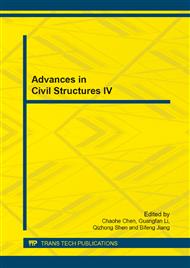[1]
Fan Lichu Bridge Engneeriing. Beijing: China Communications Press, 2006: 84.
Google Scholar
[2]
Meng Yun Bridge reinforcement and structural. Beijing: China Communications Press, 2004: 118.
Google Scholar
[3]
Huang Minshui, Niu Hongping. Study on mechanism and reinforcement processing of single slab bearing, disease of hollow core slab beam bridge. Journal of Huazhong University of Science and Technology(Nature Science Edition)2008, 36(2): 118-121.
Google Scholar
[4]
Zhao Man, WangXiinmin, Zhao Yake. Numerical Analysis on Single Plate Bearing, of Plate Girder Bridge. China Safety Science Journal. 2004, 11(14): 25~29.
Google Scholar
[5]
Zeng Ke, Zhang Junping. Analysis of the horizontal connection and reinforcement measures on hollow slab. Journal of Guangzhou University(Natural Science Edition) , 2011, (06): 68-72.
Google Scholar
[6]
Chen Huai, Zou Xuyan, Wang Yan, Zhu Juntao, Qian Hui. Analysis of Ultmiate Bearing Capacity for Hollow Slab Bridge Strengthened by Prestressed CFRP Sheets. Journal of Highway and Transportation Research and Development, 2010, (09): 68-72, 79.
Google Scholar
[7]
Hu Qingan, Zhang Tongzhou, Wu Xiaoguang, Shi Jianpeng. Application of U-shaped steel in bridge reinforcement. Highway, 2011, (10): 98-101.
Google Scholar
[8]
Yuan Aimin, Zhou Yuanhua, Dai Hang, Sun Dasong. A new type of prestressed concrete hollow girder design for overcoming the typical diseases. Journal of Chongqing University, 2012, (10): 124-129.
Google Scholar
[9]
Wei Mingguang, Li Guoping. Comparison of Transverse Joint Types of Precast Concrete Cellular Slab Bridges. Structural Engineers, 2012, (05): 25-30.
Google Scholar
[10]
Aparicio A C,Ramos G,Casas J R. Testing of Externally Pretressed Concrete Beams. Engineering Structures,2002,24: 73-84.
DOI: 10.1016/s0141-0296(01)00062-1
Google Scholar
[11]
Zhang Yunna. Study on bridge assembly type hollow reinforced by transverse Prestress Ing. Zhengzhou University, (2007).
Google Scholar
[12]
Wang Tong, Wang Zonglin, Zhang Shuren. Ultimate analysis for externally prestressed simple supported concrete beam with random reinforcement. China Journal of Highway and Transport, 2002, 15(2): 61-67.
Google Scholar
[13]
Roschke Paul N, Inoue Masamichi. Effects of banded post-tensioning in pretressed concrete flat slab. Journal of Structural Engneering, 1991, 117(2): 563-583.
DOI: 10.1061/(asce)0733-9445(1991)117:2(563)
Google Scholar
[14]
Xu Dong, Xiang Haifan. Ultimate Behavior of Externally Prestressed Concrete Bridges and Analysis of Inf luencing Factors. BRIDGE CONSTRUCTION, 1999, (3): 1~4, 7.
Google Scholar
[15]
Xiang Yiqianig, Shao Linhai, Xing Yuan, Zhao Chunfeng. Spatial behavior and strengthening analysis of fabricated PC hollow slab beam bridge with hinge joints. Journal of Southeast University(Natural Science Edition), 2012, 42(4): 734-738.
Google Scholar
[16]
Standards Council of Canada. CAN/CSA-S6-00 Canadian highway bridge design code. Ontario: CSA International, (2000).
Google Scholar
[17]
Nam JW, etal. International perspective: overview and application of precast bos-beam bridges in Korea. PCI Journal, 2008, 53(4): 83-107.
Google Scholar
[18]
AASHTO. AASHTO LRFD bridge design specifications. 4 th Edition. American Association of state Highway and transportation Officials, (2007).
Google Scholar
[19]
Yu Bo. Experimental study of prefabricated concrete hollow plate girder bridge integral Reinforcement. Southeast University, (2011).
Google Scholar
[20]
Xu Dong. Externally prestressed concrete bridges Design . Beijing: China Communications Press, (2008).
Google Scholar


